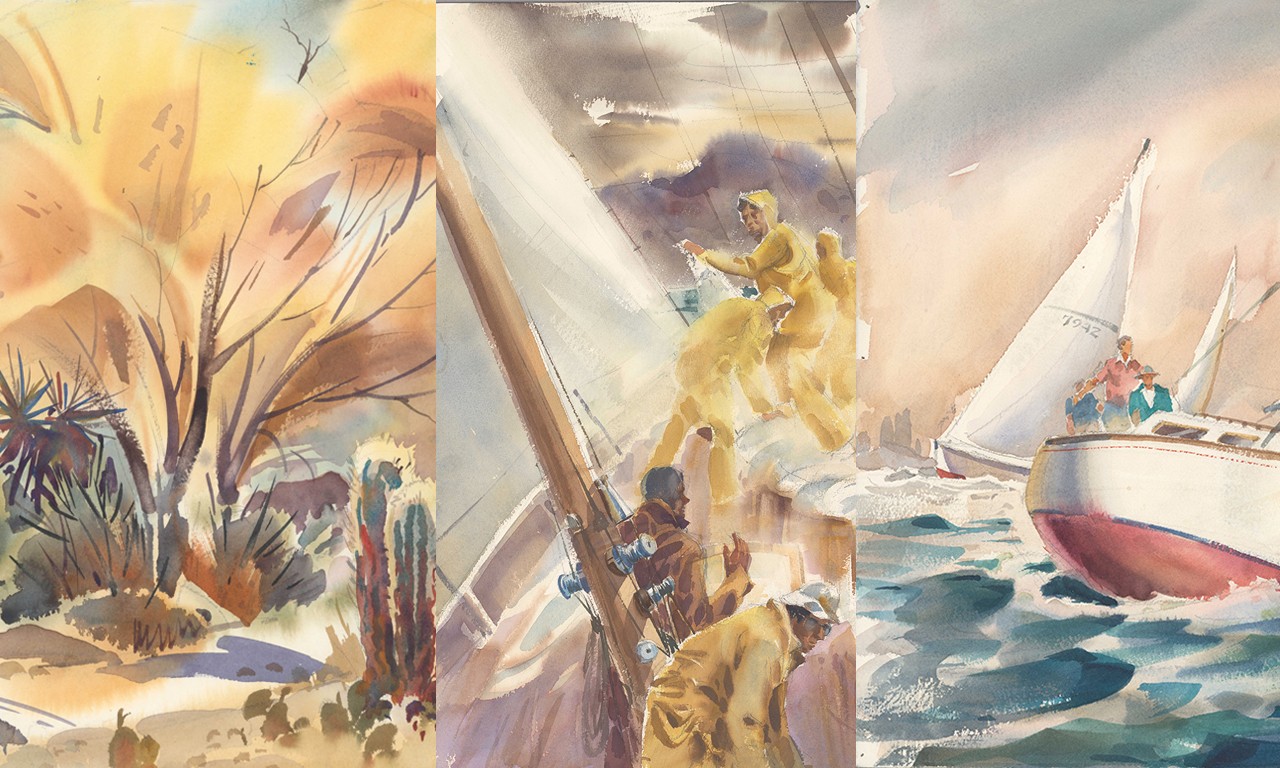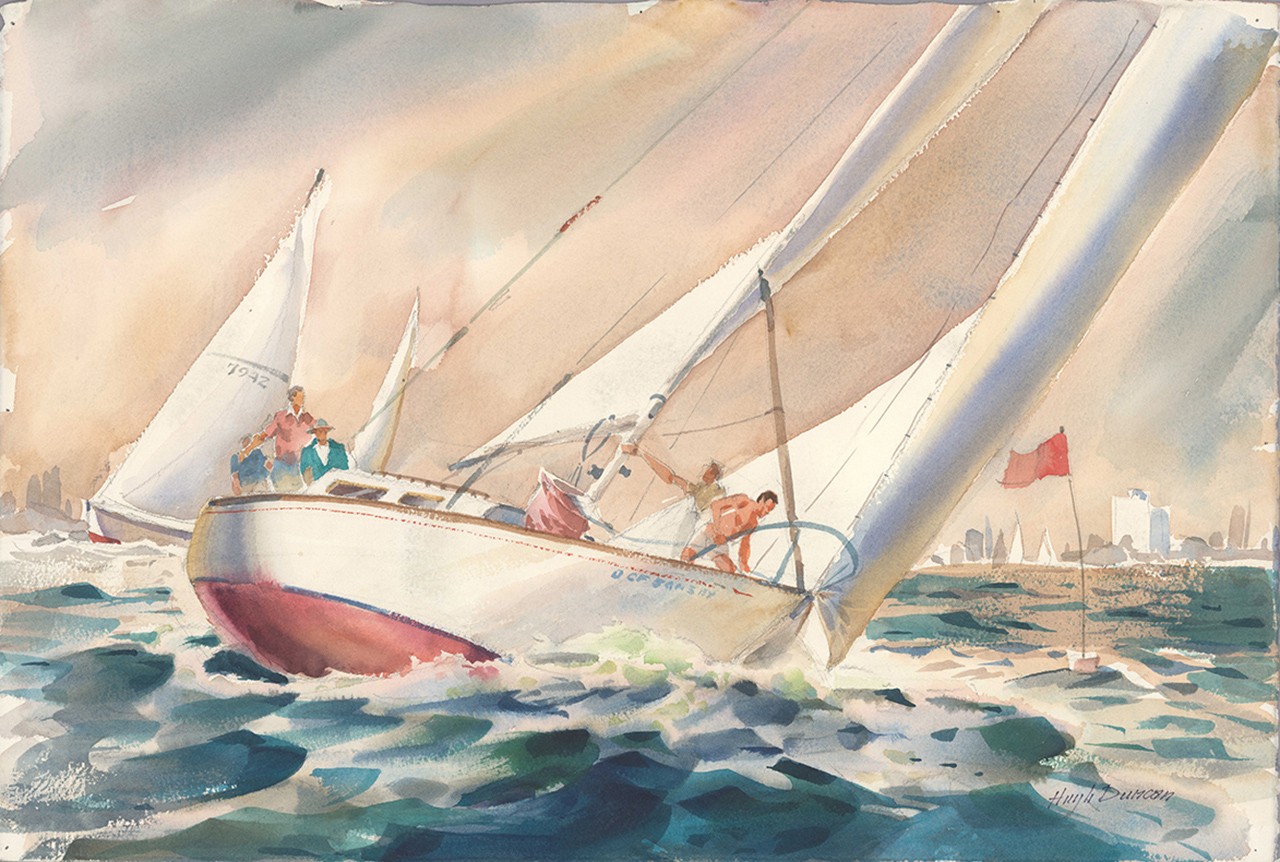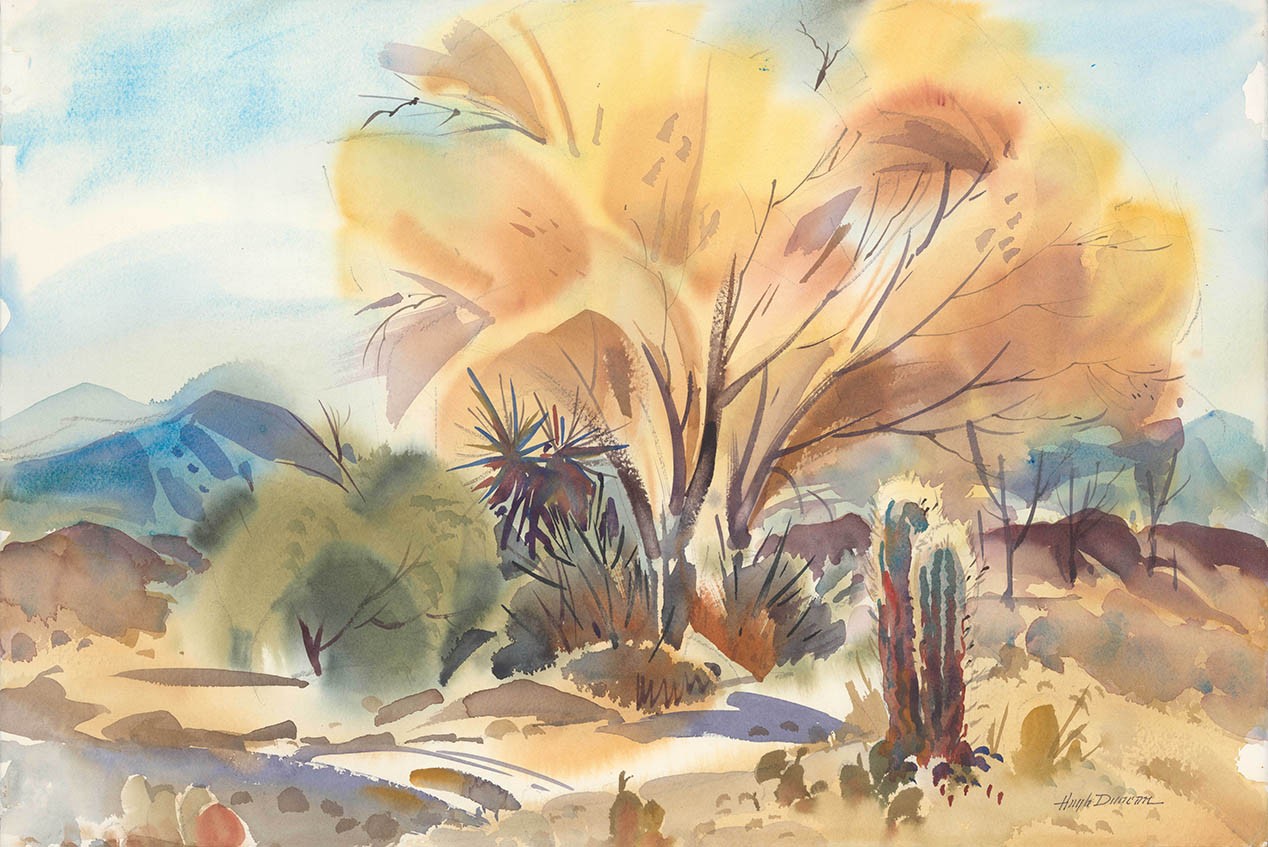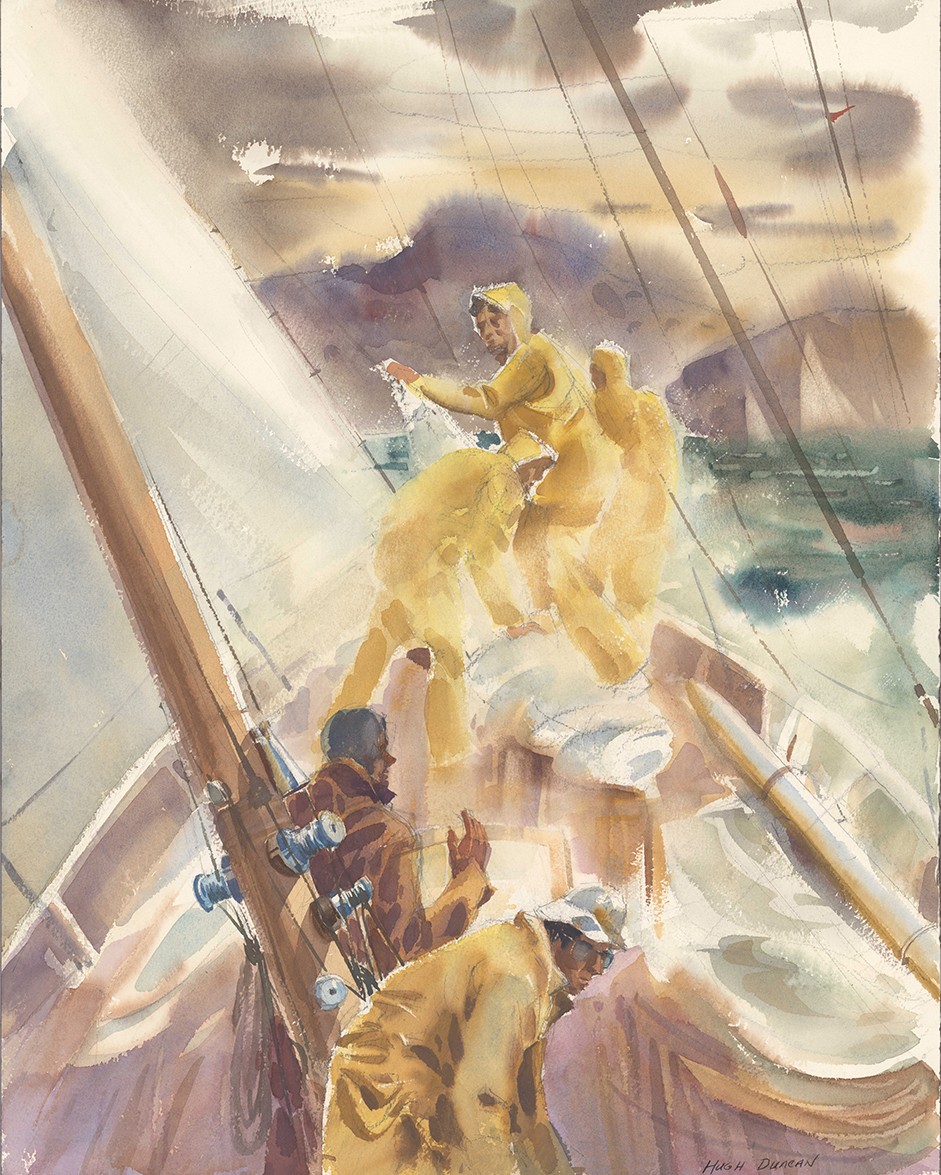 |
|
Detail of Sonoran Landscape, Round the Mark, and Foredeck Action in Heavy Weather
Gift of the Irene Duncan Family Trust and Larry Duncan, 2024.9.31, .71, .97
|
With a mission to enrich lives through the world’s finest arts and cultures, Bowers Museum actively acquires objects through strategic purchases and by accepting gifts from generous individuals and institutions. This post in the New Acquisitions series features late California painter, Hugh Duncan (American, 1924–2001) and three works among the 142 watercolor and oil paintings recently gifted by the Irene Duncan Family Trust and Larry Duncan, his son.
This substantial gift not only strengthens Bowers’ California Plein Air collection, but also represents the largest holding of Duncan’s works by a museum or institution, offering a rare look at a modest painter whose abilities far exceeded his public acclaim.
Charting Duncan’s Journey
Born in Glendale in April 1924, descended from a lineage of California trailblazers, Hugh Duncan was raised in a household shaped by resilience and ambition. His mother, Aleen Fern Kingcade, was the pillar of the family, raising Duncan and his three younger siblings. She knit the family from her own inborn strength and championed education as a means of empowerment; while, his father, Arthur Duncan, a brilliant engineer and one of several supervisors for Hoover Dam’s construction—may well have passed down the creative ingenuity that informed his artiistic vision.
Duncan graduated from Herbert Hoover High School in 1942 and enlisted shortly thereafter in the Navy, serving during World War II. He flew only but a single mission in the historic Battle of Leyte Gulf before returning home under the GI Bill, which enabled him to pursue his passions of music and art at the Conservatory of Music and at several art institutions in Los Angeles including School of Allied Arts, Art Center School, Jepson Art School, and Chouinard Art Institute.
As a young man, Duncan worked with the Glendale Fire Department and as a drummer, notably having performed with American Jazz trumpeter, Doc Severinsen. Though it was not until he met his wife in the late 1940s that Duncan settled down to pursue a career as a commercial illustrator, also teaching watercolor workshops.
 |
|
Hugh Duncan
American, 1924–2001
Round the Mark
mid to late 20th century
Watercolor on paper; 22 × 30 in.
Gift of the Irene Duncan Family Trust and Larry Duncan, 2024.9.97
|
Scenes at Sea
As a lifelong enthusiast of sailing, Duncan often spent his leisure hours at sailing competitions or cruising Southland’s harbors with his friends and family. Quintessential of the seascapes and the maritime drama at the heart of Duncan’s oeuvre, Round the Mark portrays a race off Long Beach sometime between the late 60s and early 70s as the lead sailboat prepares the spinnaker for the next leg. At the center, windswept sails and billowing waves draw the eye to a pearl-white vessel cutting through a turbulent sea, rendered in cool shades of jade green and cobalt blue. The crew members’ movements on deck are foregrounded by the overcast sky and the shimmering sea’s chromatic reflections. In the background, a buoy with a red flag marks the course, while the faint silhouettes of vessels and a sprawling city skyline punctuate the picturesque horizon—a poignant memory of early Long Beach City.
Duncan’s deft handling of watercolor and his heroic portrayal of figures amid their idealized natural surroundings aligns him with California Scene painters active during the 20th century, who were inspired by the impressionistic and plein-air sensibilities of the Barbizon School in France and the French painters of nature. Among them, Millard Sheets, Rex Brandt, and Arthur Beaumont—each previously featured in a Bowers Blog—coincidentally studied and taught at Chouinard, a context that make the painterly hallmarks of Duncan’s style all the more compelling.
 |
|
Hugh Duncan
American, 1924–2001
Sonoran Landscape
mid to late 20th century
Watercolor on paper; 22 × 30 in.
Gift of the Irene Duncan Family Trust and Larry Duncan, 2024.9.71
|
Sonoran in Full Hugh
Watercolor, well-suited for painting en plein air, flourished in the Western Frontier’s radiant climate. The medium’s portability and quick-drying properties enabled scene painters to work outdoors both with immediacy and spontaneity in order to capture the fleeting effects of light and weather across different environs. More than remarkably beautiful, these paintings are also documents of the great changes that were taking place.
In Sonoran Landscape, a lush oasis of flora and cacti is executed amid an arid countryside. A desert willow bursts with vitality, its golden-yellow and orange foliage infused with the sun’s radiance through gestural brushstrokes. Near the base, clusters of shrubs, spiky agave, and saguaro cacti executed in short, fine lines and in earth tones with muted greens balance the tree’s brilliance. As in many of Duncan’s works, a horizon grounds the composition—in this scene, a range of mountains meets a cerulean sky. The juxtaposition of warm foreground hues and cool background tones are evocative of the quiet grandeur of the wilderness that enthralled scene painters like Duncan, who painted this work during a trip to Arizona and New Mexico in his occasional bouts to the deserts of the American Southwest.
 |
|
Hugh Duncan
American, 1924–2001
Foredeck Action in Heavy Weather
mid to late 20th century
Watercolor on paper; 24 × 19 in.
Gift of the Irene Duncan Family Trust and Larry Duncan, 2024.9.31
|
Plein Air en Motion
Lastly, Foredeck Action in Heavy Weather, currently featured in First Look: New Acquisitions at Bowers Museum, exemplifies Duncan’s consummate mastery of watercolor in capturing kinetic motion. Here, his pioneering approach is marked by the first-person vantage point and dynamic composition. Amid the action, figures clad in bright yellow foul weather gear wrestle with the head sails as waves relentlessly surge over the top edge of the hull. Maritime drama unfolds with frenetic intensity as the eye follows the vessel’s pointed contour with the frame in focus becoming ever narrower. The scene reaches its climax at the tip of the bow where the figures’ hurried motions seemingly converge with the boundless horizon and the encroaching storm, all but obscuring the perilous path before them—beckoning the question of what lies beyond the visible threshold.
Duncan’s paintings suggest a personal imperative to chart new territory, perhaps a reflection of his pioneering heritage. Though his alignment with California’s Plein Air painters is apparent, his knack for capturing kinetic motion remains uniquely his own.
Text and images may be under copyright. Please contact Collection Department for permission to use. References are available on request. Information subject to change upon further research.





Comments 1
Your writing capures the magial essence of the West in a way that is both inspirational and informative.